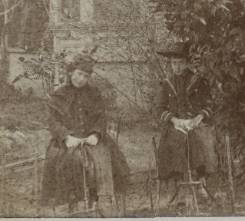In March 2013 a short term funded project was started to catalogue miscellaneous Alfred Russel Wallace manuscripts. These items were recently added to the Library's larger Wallace collection, and consist of items such as printed ephemera, photographs, cuttings, maps (including constellation), notebooks and other miscellaneous items (for example, a lock of hair belonging to his friend Richard Spruce). These items are generally those collected by A. R. Wallace, rather than written or made by him
Diane Tough is the cataloguer employed to undertake this interesting project, which is funded until November 2013.
Information relating to each individual item is recorded into CALM, the Archives online catalogue, and is available immediately via our website for the use of researchers. Each item is given a individual reference number, described, measured and specific information is recorded; such as a physical description, any markings or notes that it contains etc. On average approximately 25 items are processed per day.
As a result of the work she has already completed for this project, Diane has learnt new information about Wallace, his personal life and family. This includes;
- His artistic talent
- William, his brother, was also a talented artist
- Wallace was interested in phrenology
Diane is thoroughly enjoying the variety of items that she is handling and the stories they tell. The following are examples of some of her favourites:
Address presented to the Reverend W. P. Stephens
[Pictured with Diane above]
Results of a Phrenological study taken of A. R. Wallace by James Quilter Rumball - dated 1845. It includes the development chart and handwritten character analysis WP18/39 [Pictured above]
Wallace is scored on a scale of 6 (very small) to 10 (very large). Some examples include:
Locality - sense of place, of space - love of travelling = Score 9
Destructiveness - impluse to destroy, by word or deed = score 8
Proofs of woodcut illustrations for Wallace's publication 'The Malay Archipelago', these are by multiple artists (WP6/1/7 1-34) [Pictured above]
Photograph of 369 Channel Street, Stockton, California (WP2/1/25) This is believed to be the house of Wallace's brother John, who Wallace visited during his tour of America and taken circa 1887. What is particularly interesting is that it depicts two youngsters in the foreground sitting on what look to be very early bicycles. [Pictured above]




![40983_275_358_cache[1].jpg](../../../../servlet/JiveServlet/downloadImage/38-2842-45805/252-358/40983_275_358_cache[1].jpg)
